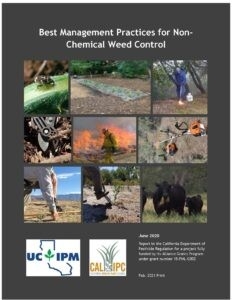Best Management Practices for Non-Chemical Weed Control 

Authors of each chapter have compiled research and on-the-ground knowledge of subject experts on tools and methods of application, as well as on efficacy of techniques under various environmental conditions and across different classes of invasive plants. Environmental, cultural, and human safety risks are also highlighted to help support safe and effective use of techniques. This manual is designed to be a go-to resource for practitioners that are either complementing their weed control work with non-chemical techniques or are exclusively restricted to not using herbicides. Individual BMPs will be incorporated into an online decision support tool still in development.
This manual is available as a free download (291 pp., 21.5 MB). Visit https://www.cal-ipc.org/resources/library/publications/non-chem/.
Contents
- Removing Whole Plants (5 techniques)
- Controlling Plants by Cutting (6 techniques)
- Controlling Plants in Place (3 techniques)
- Covering Plants with Sheet Barriers (3 techniques)
- Controlling Plants at a Plant Community Scale (4 techniques)
- Biological Control (general introduction and descriptions of agents for 18 weed species/species groups)
Acknowledgements
This manual would not have been possible without the expert knowledge generously provided by technical team members across the state.
Funding was provided by the California Department of Pesticide Regulation Alliance Grants Program (grant no. 18-PML-G002) to the California Invasive Plant Council.
Please cite this report as: Cal-IPC 2020. Best Management Practices for Non-Chemical Weed Control. Report to California Department of Pesticide Regulation under grant number 18-PML-G002. 291 pp.
For more information, contact Cal-IPC.